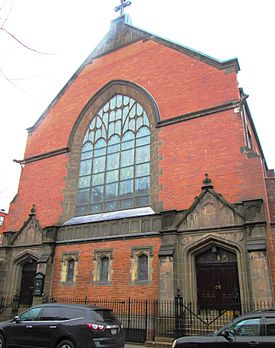St. Philip's Episcopal Church (Manhattan) facts for kids
|
St. Philip's Episcopal Church
|
|

(2014)
|
|
| Location | 210-216 West 134th Street Manhattan, New York City |
|---|---|
| Built | 1910–1911 |
| Architect | Tandy & Foster: Vertner W. Tandy George W. Foster, Jr. |
| Architectural style | Gothic Revival |
| NRHP reference No. | 08000933 |
Quick facts for kids Significant dates |
|
| Added to NRHP | September 25, 2008 |
St. Philip's Episcopal Church is a very old and important church in the Harlem neighborhood of Manhattan, New York City. It is located on West 134th Street.
The church was started in 1809 by free African Americans. They used to worship at Trinity Church, Wall Street. It was first called the Free African Church of St. Philip. This church is the oldest black Episcopal church in New York City. It has always been very important in the black community. Many of its members became leaders.
Contents
Church History
Early Beginnings
The first stone for the church building was laid in 1819. The first leader, called a rector, was Rev. Peter Williams, Jr.. He served from 1826 to 1840. He was a strong supporter of ending slavery. He was also the first African-American Episcopal priest in New York.
Many church members in the 1820s were becoming successful. They worked in jobs like service industries. They also joined groups that worked to end slavery. These groups wanted to improve education and respect for everyone.
Over the years, Black Episcopalians used their church connections. Some found success in shipping jobs. Others became teachers and doctors. Some even owned businesses like grocery stores and restaurants.
Moving Uptown
The first two church buildings were on Centre Street. In 1822, a brick building replaced the first wooden one. The wooden church had been damaged by fire. The brick church was fixed up twice after being damaged. In 1834, white people vandalized the church. During the American Civil War, in 1863, it was damaged again. Police used it as a place for soldiers during the New York City draft riots.
As New York City grew, people moved further uptown. St. Philip's Church and its members also moved north. By 1886, the church was on 25th Street. Around 1909, they sold this property for a lot of money. With that money, they bought the land for the current church. They also bought 10 apartment buildings in Harlem. This area had been only for white people before.
The church had stable leaders for many years. Rev. Hutchens C. Bishop was the rector for 47 years. His son, Shelton Hale Bishop, also served as rector for many years.
Current Building
The church building you see today was designed by Vertner Woodson Tandy and George Washington Foster. They were both important African-American architects. Tandy was the first African-American architect licensed in New York State. Foster was one of the first licensed in State of New Jersey.
The church was built between 1910 and 1911. It was designed in the Neo-Gothic style. This style looks like old European churches.
The church was named a New York City Landmark in 1993. It was also added to the National Register of Historic Places in 2008. This means it is a very important historic place.
Important Members
Many famous people have been members of St. Philip's Church.
19th Century Members
In the 1800s, some notable members included:
- Thomas Jennings
- Thomas Downing and his son George T. Downing
- Isaiah DeGrasse
- Dr. James McCune Smith
- Alexander Crummell
A local teacher named Susan Elizabeth Frazier was also a long-time member. After she passed away, other teachers placed a special plaque in the church to honor her.
20th Century Members
In the 1900s, the church had members who were leaders in politics and culture. These included:
- W. E. B. Du Bois, a professor and smart thinker.
- Thurgood Marshall, who became a Supreme Court Justice. He worked for the NAACP Legal Defense Fund.
- Langston Hughes, a famous poet and playwright.
See also
- List of New York City Landmarks
- National Register of Historic Places listings in New York County, New York
- Lafargue Clinic, a mental health clinic that operated in the church basement from 1946 to 1958




